-
SparkShuffle 概念
- reduceByKey 会将上一个RDD中的每一个key对应的所有 value 聚合成一个 value, 然后生成一个value, 然后生成一个新的 RDD, 元素资源是<key, value> 对的形式, 这样每一个 key 对应 一个聚合起来的 value。
- 问题:
- 聚合之前, 每一个key对应的 value 不一定都在一个 partition 中, 也不太可能在同一个节点上, 因为 RDD 是分布式的弹性数据集, RDD 的 partition 极有可能分布在各个节点上。
- 如何聚合?
- Shuffle Write:
- 上一个 stage 的每个 map task 就必须保证将自己处理的当前分区的数据相同的key写入一盒分区文件中, 可能会写入多个不同的分区文件中。
- Shuffle Read:
- reduce task 会从上一个stage的所有 task 所在的机器上寻找属于自己的那些分区文件, 这样就可以保证每一个 key 所对应的 value 都会汇集到同一个节点上去处理和聚合。
- Spark 中有两种Shuffle类型: HashShuffle 和 SortShuffle
- Spark1.2之前是HashShuffle, Spark1.2 引入SortShuffle
- Spark1.2 - Spark1.6之间 HashShuffle 和 SortShuffle 并存
- Spark2.0 移除了 HashShuffle, 只有SortShuffle
- Shuffle Write:
- reduceByKey 会将上一个RDD中的每一个key对应的所有 value 聚合成一个 value, 然后生成一个value, 然后生成一个新的 RDD, 元素资源是<key, value> 对的形式, 这样每一个 key 对应 一个聚合起来的 value。
-
HashShuffle
-
普通机制
-
示意图
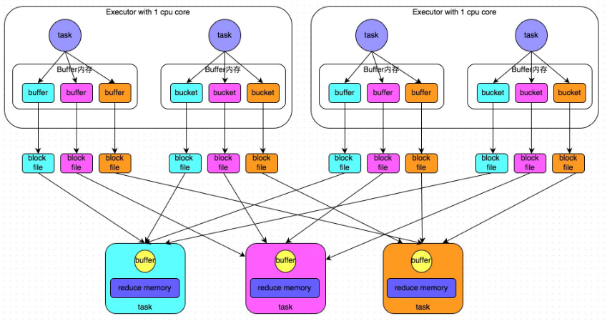
-
执行流程
- 每个 map task 将不同结果写到不同的buffer中, 每个 buffer 的大小为32K。
- 每个 buffer 文件最后对应一个磁盘小文件。
- reduce task 来拉取对应的磁盘小文件。
-
总结
- map task 的计算结果会根据分区器 (默认是 hashPartition) 来决定写入到哪一个磁盘小文件中去。
- ReduceTask 会去 Map 端拉取相应的磁盘小文件。
- 产生的磁盘小文件个数: M (map task 的个数) * R (reduce task 的个数)
-
存在的问题
- 产生的磁盘小文件过多, 会导致以下问题:
- 在 Shuffle Write 过程中会产生很多写磁盘小文件的对象
- 在 Shuffle Read 过程中会产生很多读取磁盘小文件的对象
- 在 JVM 堆内存中对象过多会造成频繁的 gc, 如果经过gc仍无法获取运行所需要的内存的话, 就会造成OOM(Out Of Memory)
- 在数据传输过程中会有频繁的网络通信, 频繁的网络通信出现通信故障的可能性大大增加, 一旦网络通信出现了故障会导致 shuffle file cannot found (找不到shuffle的文件),从而导致task失败, TaskScheduler 不负责重试, 由DAGScheduler 负责重试Stage。
- 产生的磁盘小文件过多, 会导致以下问题:
-
-
合并机制
-
合并机制示意图
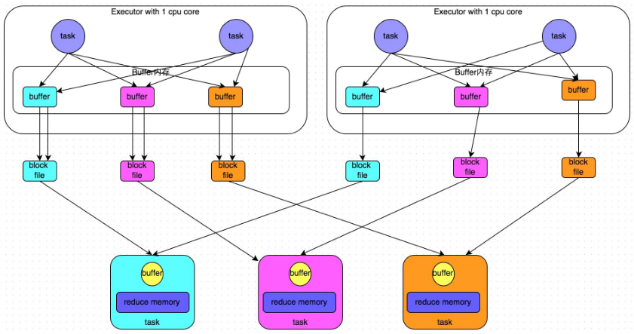
-
源码
-
ShuffleManager(Trait)

package org.apache.spark.shuffle import org.apache.spark.{ShuffleDependency, TaskContext} /** * Pluggable interface for shuffle systems. A ShuffleManager is created * in SparkEnv on the driver and on each executor, based on the * spark.shuffle.manager setting. * shuffle 系统的可植入接口。在 SparkEnv(Spark 环境)中创建了一个 * 基于spark.shuffle.manager 设置的 ShuffleManager * The driver registers shuffles with it, and executors (or tasks * running locally in the driver) can ask to read and write data. * driver 将 shuffle 任务注册, 并且executor进程(或者运行在本地的任务) 可以申 * 请数据的读写 * NOTE: this will be instantiated by SparkEnv so its constructor can * take a SparkConf and boolean isDriver as parameters. * 需要注意的是, 以上会被 SparkEnv(Env => Environment) 实例化 从而使它的构 * 造器能够获取一个 SparkConf(Spark 配置文件) 和 是否是 Driver 的标签 */ private[spark] trait ShuffleManager { /** * Register a shuffle with the manager and obtain a handle for it to * pass to tasks. * 注册一个 带管理器的 shuffle 任务 并好获取一个将它发送给 任务集的 句柄 */ //sortShuffle的实现 def registerShuffle[K, V, C]( shuffleId: Int, numMaps: Int, dependency: ShuffleDependency[K, V, C]): ShuffleHandle /** Get a writer for a given partition. Called on executors by map * tasks. * 对已得的分区获取一个writer, 通过 map tasks 在 executor 进程上调用 */ def getWriter[K, V](handle: ShuffleHandle, mapId: Int, context: TaskContext): ShuffleWriter[K, V] /** * Get a reader for a range of reduce partitions (startPartition to * endPartition-1, inclusive). * 根据一段reduce(规约)分区获取 reader * Called on executors by reduce tasks. * 通过 reduce tasks 在 executor进程上调用 */ def getReader[K, C]( handle: ShuffleHandle, startPartition: Int, endPartition: Int, context: TaskContext): ShuffleReader[K, C] /** * Remove a shuffle's metadata from the ShuffleManager. * 从Shufflemanager 移除一个 shuffle 任务的 元数据 * @return true if the metadata removed successfully, otherwise false. * 如果元数据被成功移除就返回true, 反之 false */ def unregisterShuffle(shuffleId: Int): Boolean /** * Return a resolver capable of retrieving shuffle block data based on * block coordinates. * 返回一个能基于block坐标来取回 shuffle block 中的数据的解析器 */ def shuffleBlockResolver: ShuffleBlockResolver /** Shut down this ShuffleManager. * 关闭该 shuffleManager */ def stop(): Unit } -
ShuffleReader(Trait)
package org.apache.spark.shuffle /** * Obtained inside a reduce task to read combined records from the * mappers. * 从一个 reduce task 内部 获取该 Trait的实例 以 从 mappers 中读取 总共的数据 */ private[spark] trait ShuffleReader[K, C] { /** Read the combined key-values for this reduce task * 读取 此 reduce task 的所有键值对 */ def read(): Iterator[Product2[K, C]] /** * Close this reader.关闭该 reader * TODO: Add this back when we make the ShuffleReader a developer API * that others can implement (at which point this will likely be 、 * necessary). * 当我们将 ShuffleReader 作为一个他人可以实现的开发者的API时 将以下注释放 * 开(在某些情况下这可能是必须的). * */ // def stop(): Unit } -
ShuffleWriter
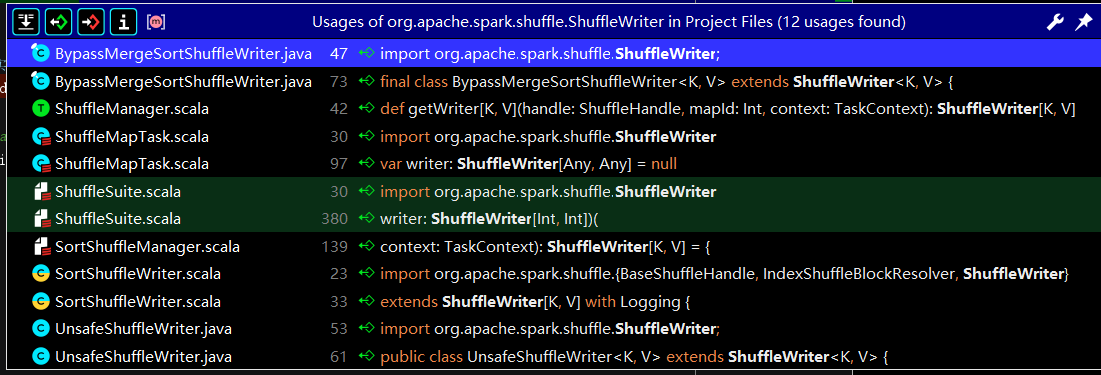
package org.apache.spark.shuffle.sort import java.util.concurrent.ConcurrentHashMap import org.apache.spark._ import org.apache.spark.internal.Logging import org.apache.spark.shuffle._ /** * In sort-based shuffle, incoming records are sorted according to their * target partition ids, then written to a single map output file. * 在 sort-based(基于排序) 的 shuffle中, 将到来的记录都会根据他们的目标分区 * id 被排序, 然后被写入到一个简单的 map 输出文件 * * Reducers fetch contiguous regions of this file in order to * read their portion of the map output. * Reducer 获取 该文件相邻的区域从而读取他们的 map 输出部分 * * In cases where the map output data is too large to fit in memory, * sorted subsets of the output can are spilled to disk and those on- * disk files are merged to produce the final output file. * 当 map 输出文件太大内存装不下时, 排序好的输出的子集可以被溢写到磁盘中, 并且 * 这些在磁盘中的(小)文件会被归并输出为最终文件 * * Sort-based shuffle has two different write paths for producing its * map output files: * Sort-based shuffle 有两种不同的 产生map 输出文件 的 写路径 * * - Serialized sorting: used when all three of the following * conditions hold: * 当以下所有三种 条件成立时, 使用serialized sorting(序列化的排序) * 1. The shuffle dependency specifies no aggregation or output * ordering. * 1. shuffle 的依赖规定了 没有聚合 以及 输出排序 * 2. The shuffle serializer supports relocation of serialized values * (this is currently supported by KryoSerializer and Spark SQL's custom * serializers). * 2. shuffle 的序列器 支持 序列化值的重新分配 (这目前 由 Kryo 序列器 和 * Spark SQK 的客户端序列器 所支持) * 3. The shuffle produces fewer than 16777216 output partitions. * 3. shuffle 任务产生了比16777216 更少的输出分区 * * - Deserialized sorting: used to handle all other cases. * - 不序列化的排序, 用于处理所有其他情况 * ----------------------- * Serialized sorting mode * ----------------------- * * In the serialized sorting mode, incoming records are serialized as * soon as they are passed to the shuffle writer and are buffered in a * serialized form during sorting. * 在序列化的排序模式中, 即将到来的记录会在他们被传送到 shuffle writer 上时就 * 马上被序列化 并 在排序过程中 被缓存为 序列化的形式 * * This write path implements several optimizations: * 此写入路径 实现了许多优化 * * - Its sort operates on serialized binary data rather than Java * objects, which reduces memory consumption and GC overheads. * 它的 排序直接操作 序列化的二进制数据 而不是 Java 对象, 这样就会减少内存消耗 * 和 GC(Garbage Collector) 开销 * * This optimization requires the record serializer to have certain * properties to allow serialized records to be re-ordered without * requiring deserialization. * 此优化需要记录的序列器依据有特定的性质来允许序列化的记录 在 不执行反序列化 * 的情况下被重新排序 * * See SPARK-4550, where this optimization was first proposed and * implemented, for more details. * 该优化在 SPARK-4550 中第一次被提出并且实施, 更多细节请查询它 * * - It uses a specialized cache-efficient * sorter([[ShuffleExternalSorter]]) that sorts arrays of compressed * record pointers and partition ids. * 它使用了 一个特殊的 高效缓存排序器(ShuffleExternalSorter[外部的 shuffle * 排序器]), 该排序器 对压缩过的记录点 数组 和 分区 id 数组 进行排序 * * By using only 8 bytes of space per record in the sorting array, this * fits more of the array into cache. * 通过 对每条记录 仅使用 排序数组中 8 字节的 空间, 这使得更多的数组能被传入缓 * 存 * * The spill merging procedure operates on blocks of serialized * records that belong to the same partition and does not need to * deserialize records during the merge. * 溢写合并过程操作了序列化的记录所在的block(块), 这些记录属于相同分区, 并 * 且不需要 在合并期间将数据反序列化 * * - When the spill compression codec supports concatenation of * compressed data, the spill merge simply concatenates the serialized * and compressed spill partitions to produce the final output * partition. * 当溢写压缩代码编译器 支持了 压缩数据 的合并时, 该溢写过程仅仅合并了序列化且 * 压缩的溢写分区来产生最终的输出分区. * * This allows efficient data copying methods, like NIO's `transferTo`, * to be used and avoids the need to allocate decompression or copying * buffers during the merge. * 这使得数据能被高效地拷贝, 就像 NIO(Not Blocked IO) 中的 transferTo(转换 * 到), 在被使用时避免了在 合并时 分配解压缩 或 将缓存拷贝。 * * For more details on these optimizations, see SPARK-7081. * 对于这些优化的更多细节,请查询 SPARK-7081 */ private[spark] class SortShuffleManager(conf: SparkConf) extends ShuffleManager with Logging { if (!conf.getBoolean("spark.shuffle.spill", true)) { logWarning( "spark.shuffle.spill was set to false, but this configuration is ignored as of Spark 1.6+." + " Shuffle will continue to spill to disk when necessary.") } /** * A mapping from shuffle ids to the number of mappers producing * output for those shuffles. * 使用一个ConcurrentHashMap 来存储shuffles的中间结果 */ private[this] val numMapsForShuffle = new ConcurrentHashMap[Int, Int]() // 重写 shuffleBlock 解析器 override val shuffleBlockResolver = new IndexShuffleBlockResolver(conf) /** * Obtains a [[ShuffleHandle]] to pass to tasks. * 获取一个 shuffle 句柄来传递任务 */ /** * SortShuffleManager中有几个重要的方法 * getReader :读取数据 * getWriter :写数据 * registerShuffle : 注册shuffle */ override def registerShuffle[K, V, C]( shuffleId: Int, numMaps: Int, dependency: ShuffleDependency[K, V, C]): ShuffleHandle = { //判断是否使用sortShuffle 中的BypassMergeSort if (SortShuffleWriter.shouldBypassMergeSort(conf, dependency)) { // If there are fewer than spark.shuffle.sort.bypassMergeThreshold partitions and we don't // need map-side aggregation, then write numPartitions files directly and just concatenate // them at the end. This avoids doing serialization and deserialization twice to merge // together the spilled files, which would happen with the normal code path. The downside is // having multiple files open at a time and thus more memory allocated to buffers. /** * 如果是少于参数 spark.shuffle.sort.bypassMergeThreshold 的分区,不需要map端预聚合,直接向buffer 缓存区中写数据,最后将它们连接起来。 * 这样避免了在shuffle 落地文件合并时的 序列化和反序列 过程。缺点是需要分配更多的内存。 */ new BypassMergeSortShuffleHandle[K, V]( shuffleId, numMaps, dependency.asInstanceOf[ShuffleDependency[K, V, V]]) } else if (SortShuffleManager.canUseSerializedShuffle(dependency)) { // Otherwise, try to buffer map outputs in a serialized form, since this is more efficient: //使用序列化的形式写入buffer缓存区,存的更多,高效 new SerializedShuffleHandle[K, V]( shuffleId, numMaps, dependency.asInstanceOf[ShuffleDependency[K, V, V]]) } else { // Otherwise, buffer map outputs in a deserialized form: //不使用序列化直接写入buffer缓存区 new BaseShuffleHandle(shuffleId, numMaps, dependency) } } /** * Get a reader for a range of reduce partitions (startPartition to 、 * endPartition-1, inclusive). * 获取一段 reduce 分区的读取器 * Called on executors by reduce tasks. * 在 executor 进程上被 reduce 任务调用 */ override def getReader[K, C]( handle: ShuffleHandle, startPartition: Int, endPartition: Int, context: TaskContext): ShuffleReader[K, C] = { new BlockStoreShuffleReader( handle.asInstanceOf[BaseShuffleHandle[K, _, C]], startPartition, endPartition, context) } /** Get a writer for a given partition. Called on executors by map * tasks. * 获取一段分区的写入者 在 executor 进程上被 map 任务调用 */ override def getWriter[K, V]( handle: ShuffleHandle, mapId: Int, context: TaskContext): ShuffleWriter[K, V] = { numMapsForShuffle.putIfAbsent( handle.shuffleId, handle.asInstanceOf[BaseShuffleHandle[_, _, _]].numMaps) val env = SparkEnv.get handle match { case unsafeShuffleHandle: SerializedShuffleHandle[K @unchecked, V @unchecked] => new UnsafeShuffleWriter( env.blockManager, shuffleBlockResolver.asInstanceOf[IndexShuffleBlockResolver], context.taskMemoryManager(), unsafeShuffleHandle, mapId, context, env.conf) case bypassMergeSortHandle: BypassMergeSortShuffleHandle[K @unchecked, V @unchecked] => new BypassMergeSortShuffleWriter( env.blockManager, shuffleBlockResolver.asInstanceOf[IndexShuffleBlockResolver], bypassMergeSortHandle, mapId, context, env.conf) case other: BaseShuffleHandle[K @unchecked, V @unchecked, _] => new SortShuffleWriter(shuffleBlockResolver, other, mapId, context) } } /** Remove a shuffle's metadata from the ShuffleManager. * 从 ShuffleManager 移除一个 shuffle 的元数据 */ override def unregisterShuffle(shuffleId: Int): Boolean = { Option(numMapsForShuffle.remove(shuffleId)).foreach { numMaps => (0 until numMaps).foreach { mapId => shuffleBlockResolver.removeDataByMap(shuffleId, mapId) } } true } /** Shut down this ShuffleManager. 关闭这个ShuffleManager */ override def stop(): Unit = { shuffleBlockResolver.stop() } } private[spark] object SortShuffleManager extends Logging { /** * The maximum number of shuffle output partitions that * SortShuffleManager supports when buffering map outputs in a * serialized form. * 当缓存 map 的输出是一个序列化的形式缓存 map 输出SortShuffleManager 所支 * 持的最大 shuffle 分区数。 * * This is an extreme defensive programming measure, since it's * extremely unlikely that a single shuffle produces over 16 million * output partitions. * 这是一个十分保守的编程策略, 即单个Shuffle产生超过160万 的输出分区是基本 * 不可能的。 * */ val MAX_SHUFFLE_OUTPUT_PARTITIONS_FOR_SERIALIZED_MODE = PackedRecordPointer.MAXIMUM_PARTITION_ID + 1 /** * Helper method for determining whether a shuffle should use an * optimized serialized shuffle path or whether it should fall back to * the original path that operates on deserialized objects. * 用于决定一个 shuffle 是否应当使用一个优化的序列化 shuffle 路径 或 它是 * 否应当 落回 操作非序列化的对象的 原始路径 */ def canUseSerializedShuffle(dependency: ShuffleDependency[_, _, _]): Boolean = { val shufId = dependency.shuffleId val numPartitions = dependency.partitioner.numPartitions if (!dependency.serializer.supportsRelocationOfSerializedObjects) { log.debug(s"Can't use serialized shuffle for shuffle $shufId because the serializer, " + s"${dependency.serializer.getClass.getName}, does not support object relocation") false } else if (dependency.aggregator.isDefined) { log.debug( s"Can't use serialized shuffle for shuffle $shufId because an aggregator is defined") false } else if (numPartitions > MAX_SHUFFLE_OUTPUT_PARTITIONS_FOR_SERIALIZED_MODE) { log.debug(s"Can't use serialized shuffle for shuffle $shufId because it has more than " + s"$MAX_SHUFFLE_OUTPUT_PARTITIONS_FOR_SERIALIZED_MODE partitions") false } else { log.debug(s"Can use serialized shuffle for shuffle $shufId") true } } } /** * Subclass of [[BaseShuffleHandle]], used to identify when we've chosen * to use the serialized shuffle. * BaseShuffleHandle(基本shuffle 的句柄)的子类, 当我们选择去使用序列化 * shuffle 时用于鉴别 */ private[spark] class SerializedShuffleHandle[K, V]( shuffleId: Int, numMaps: Int, dependency: ShuffleDependency[K, V, V]) extends BaseShuffleHandle(shuffleId, numMaps, dependency) { } /** * Subclass of [[BaseShuffleHandle]], used to identify when we've chosen * to use the bypass merge sort shuffle path. * BaseShuffleHandle(基本shuffle 的句柄)的子类, 当我们选择使用 bypass 合并 * shuffle 方式时进行鉴别 */ private[spark] class BypassMergeSortShuffleHandle[K, V]( shuffleId: Int, numMaps: Int, dependency: ShuffleDependency[K, V, V]) extends BaseShuffleHandle(shuffleId, numMaps, dependency) { } -
SortShuffleWriter
package org.apache.spark.shuffle.sort import org.apache.spark._ import org.apache.spark.internal.Logging import org.apache.spark.scheduler.MapStatus import org.apache.spark.shuffle.{BaseShuffleHandle, IndexShuffleBlockResolver, ShuffleWriter} import org.apache.spark.storage.ShuffleBlockId import org.apache.spark.util.Utils import org.apache.spark.util.collection.ExternalSorter private[spark] class SortShuffleWriter[K, V, C]( shuffleBlockResolver: IndexShuffleBlockResolver, handle: BaseShuffleHandle[K, V, C], mapId: Int, context: TaskContext) extends ShuffleWriter[K, V] with Logging { private val dep = handle.dependency private val blockManager = SparkEnv.get.blockManager private var sorter: ExternalSorter[K, V, _] = null // Are we in the process of stopping? Because map tasks can call stop() with success = true // and then call stop() with success = false if they get an exception, we want to make sure // we don't try deleting files, etc twice. private var stopping = false private var mapStatus: MapStatus = null private val writeMetrics = context.taskMetrics().shuffleWriteMetrics /** Write a bunch of records to this task's output */ override def write(records: Iterator[Product2[K, V]]): Unit = { sorter = if (dep.mapSideCombine) { require(dep.aggregator.isDefined, "Map-side combine without Aggregator specified!") new ExternalSorter[K, V, C]( context, dep.aggregator, Some(dep.partitioner), dep.keyOrdering, dep.serializer) } else { // In this case we pass neither an aggregator nor an ordering to the sorter, because we don't // care whether the keys get sorted in each partition; that will be done on the reduce side // if the operation being run is sortByKey. new ExternalSorter[K, V, V]( context, aggregator = None, Some(dep.partitioner), ordering = None, dep.serializer) } //每次数据溢写磁盘 sorter.insertAll(records) // Don't bother including the time to open the merged output file in the shuffle write time, // because it just opens a single file, so is typically too fast to measure accurately // (see SPARK-3570). //下面就是将数据写往一个文件 val output = shuffleBlockResolver.getDataFile(dep.shuffleId, mapId) val tmp = Utils.tempFileWith(output) try { val blockId = ShuffleBlockId(dep.shuffleId, mapId, IndexShuffleBlockResolver.NOOP_REDUCE_ID) val partitionLengths = sorter.writePartitionedFile(blockId, tmp) shuffleBlockResolver.writeIndexFileAndCommit(dep.shuffleId, mapId, partitionLengths, tmp) mapStatus = MapStatus(blockManager.shuffleServerId, partitionLengths) } finally { if (tmp.exists() && !tmp.delete()) { logError(s"Error while deleting temp file ${tmp.getAbsolutePath}") } } } /** Close this writer, passing along whether the map completed */ override def stop(success: Boolean): Option[MapStatus] = { try { if (stopping) { return None } stopping = true if (success) { return Option(mapStatus) } else { return None } } finally { // Clean up our sorter, which may have its own intermediate files if (sorter != null) { val startTime = System.nanoTime() sorter.stop() writeMetrics.incWriteTime(System.nanoTime - startTime) sorter = null } } } } private[spark] object SortShuffleWriter { def shouldBypassMergeSort(conf: SparkConf, dep: ShuffleDependency[_, _, _]): Boolean = { // We cannot bypass sorting if we need to do map-side aggregation. if (dep.mapSideCombine) { //map 端有预聚合的操作,不能使用bypass 机制 require(dep.aggregator.isDefined, "Map-side combine without Aggregator specified!") false } else { //map 端没有预聚合,但是分区大于 参数 spark.shuffle.sort.bypassMergeThreshold = 200 也不能使用bypass 机制。 val bypassMergeThreshold: Int = conf.getInt("spark.shuffle.sort.bypassMergeThreshold", 200) dep.partitioner.numPartitions <= bypassMergeThreshold } } }
-
-
总结
- 产生磁盘小文件的个数: C(使用的cpu core 个数) * R(reduce 的个数)
-
-
-
SortShuffle
-
普通机制
-
示意图

-
执行流程
- map task 的计算结果会写入到一个内存数据结构中, 内存数据结构默认是 5M。
- 在 shuffle 的时候会启动一个定时器, 不定期的去估算这个内存结果的大小, 当内存结构中的数据超过5M时(设为N), 它会申请 (N * 2 - 5) M 内存给内存数据结构。
- 如果申请成功不会进行溢写, 如果申请不成功, 这时候会溢写磁盘。
- 在溢写之前, 内存结构中的数据会进行排序分区。
- 溢写磁盘是以 batch 形式去写, 一个 batch 是 10000 条数据。
- map task 执行完成后, 会将这些磁盘小文件合并成一个大的磁盘文件, 同时生成一个索引文件。
- reduce task 去 map 端拉取数据的时候, 首先解析索引文件, 根据索引 文件再去拉取对应的数据。
-
总结
- 产生磁盘小文件的个数: 2*M (map task的个数)
-
-
bypass机制
-
示意图
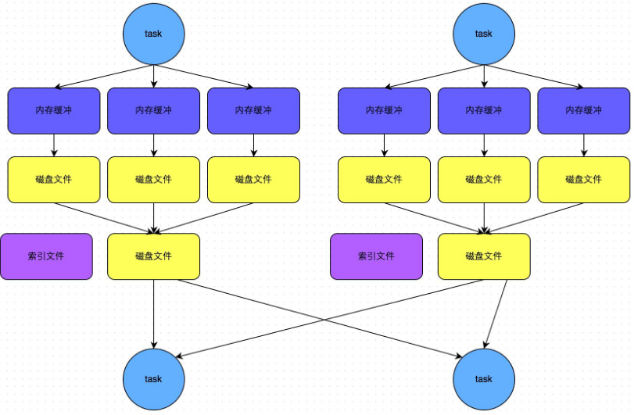
-
总结
- shuffle reduce task 的数量小于 spark.shuffle.sort.bypassMergeThreshold 的参数值。(该值默认是200)
- 产生的磁盘小文件数: 2*M (map task 的个数)
-
-
-
Shuffle 文件寻址
-
MapOutputTracker
- MapOutputTacker 是 Spark 架构中的一个模块, 是一个主从架构。
- 负责管理磁盘小文件的地址
- MapOutputTrackerMaster 是主对象, 存在于 Driver中。
- MapOutputTrackerWorker 是从对象, 存在于 Executor。
-
BlockManager
- BlockManager 块管理者, 是Spark架构中的一个模块, 也是一个主从架构。
- BlockManagerMaster
- BlockManagerWorker
- 无论在 Driver 端的BlockManager 还是在 Executor 端的 BlockManager 都含有四个对象:
- DiskStore
- MemoryStore
- ConnectionManager
- BlockTransferWorker
-
Shuffle文件寻址图
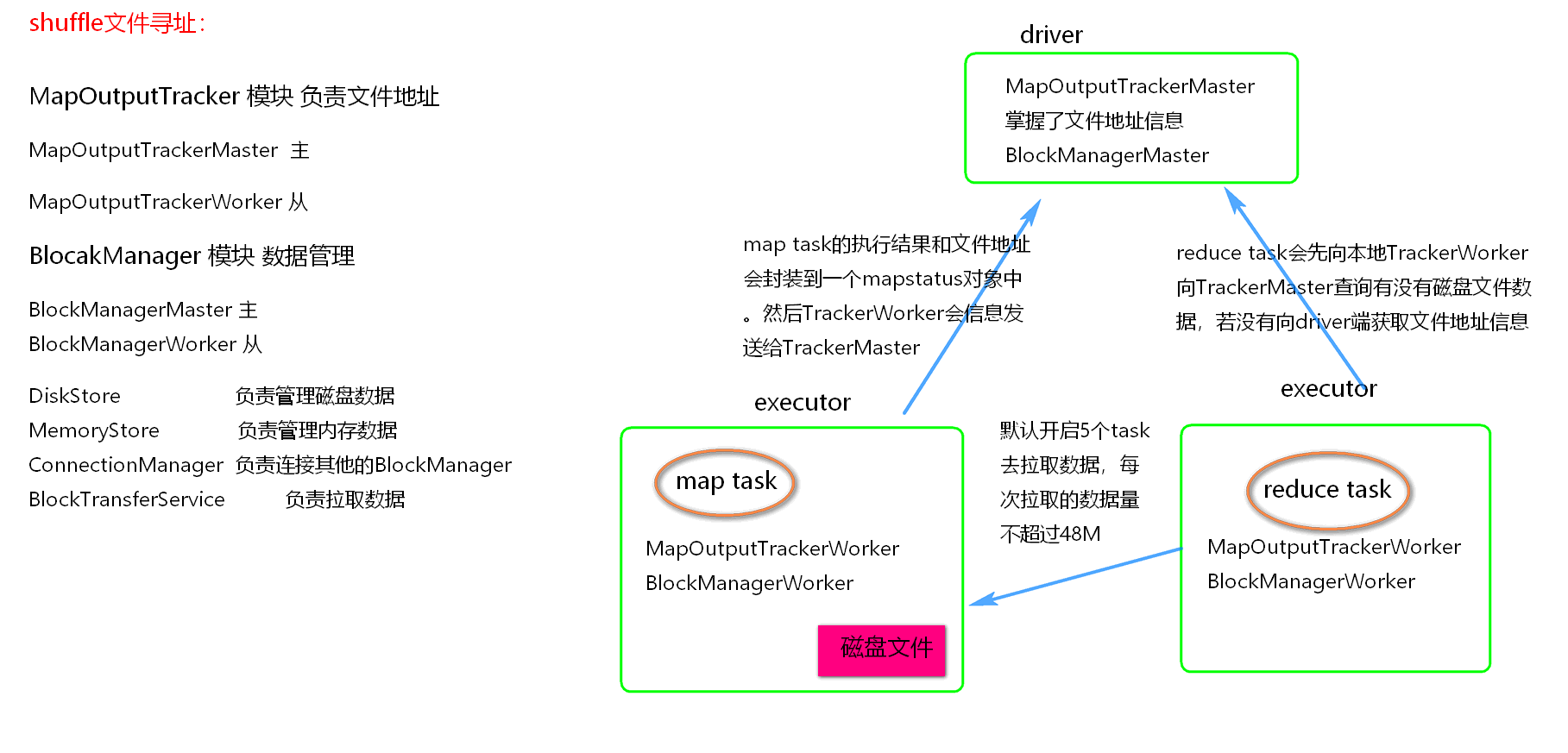
-
Shuffle 文件寻址流程
- 当 map task 执行完成后, 会将 task 的执行情况和磁盘小文件的地址封装到 MpStatus 对象中, 通过 MapOutputTrackerWorker 对象向Driver中的 MapOutputTrackerMaster 汇报。
- 在所有的map task 执行完毕后, Driver中就掌握了所有的磁盘小文件的地址。
- 在 reduce task 执行之前, 会通过 Executor 中 MapOutPutTrackerWorker 向 Driver 端的 MapOutputTrackerMaster 获取磁盘小文件的地址。
- 获取到磁盘小文件的地址后, 会通过 BlockManager 中的 ConnectionManager 连接数据所在节点上的 ConnectionManager, 然后通过BlockTransferService 进行数据的传输。
- BlockTransferService 默认启动 5 个 task 去节点拉取数据。默认情况下, 5 个 task 拉取数据量不能超过 48M。
-